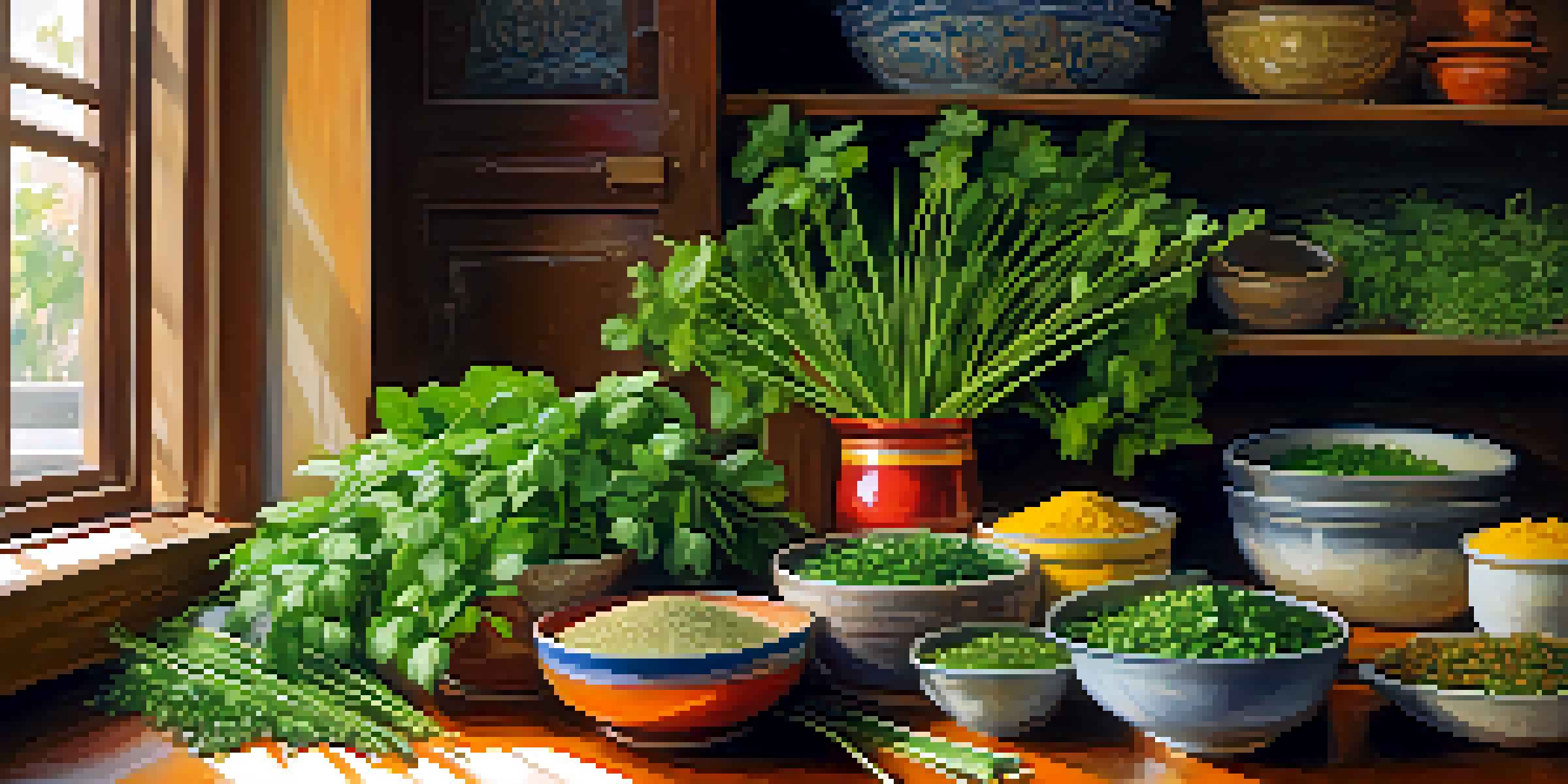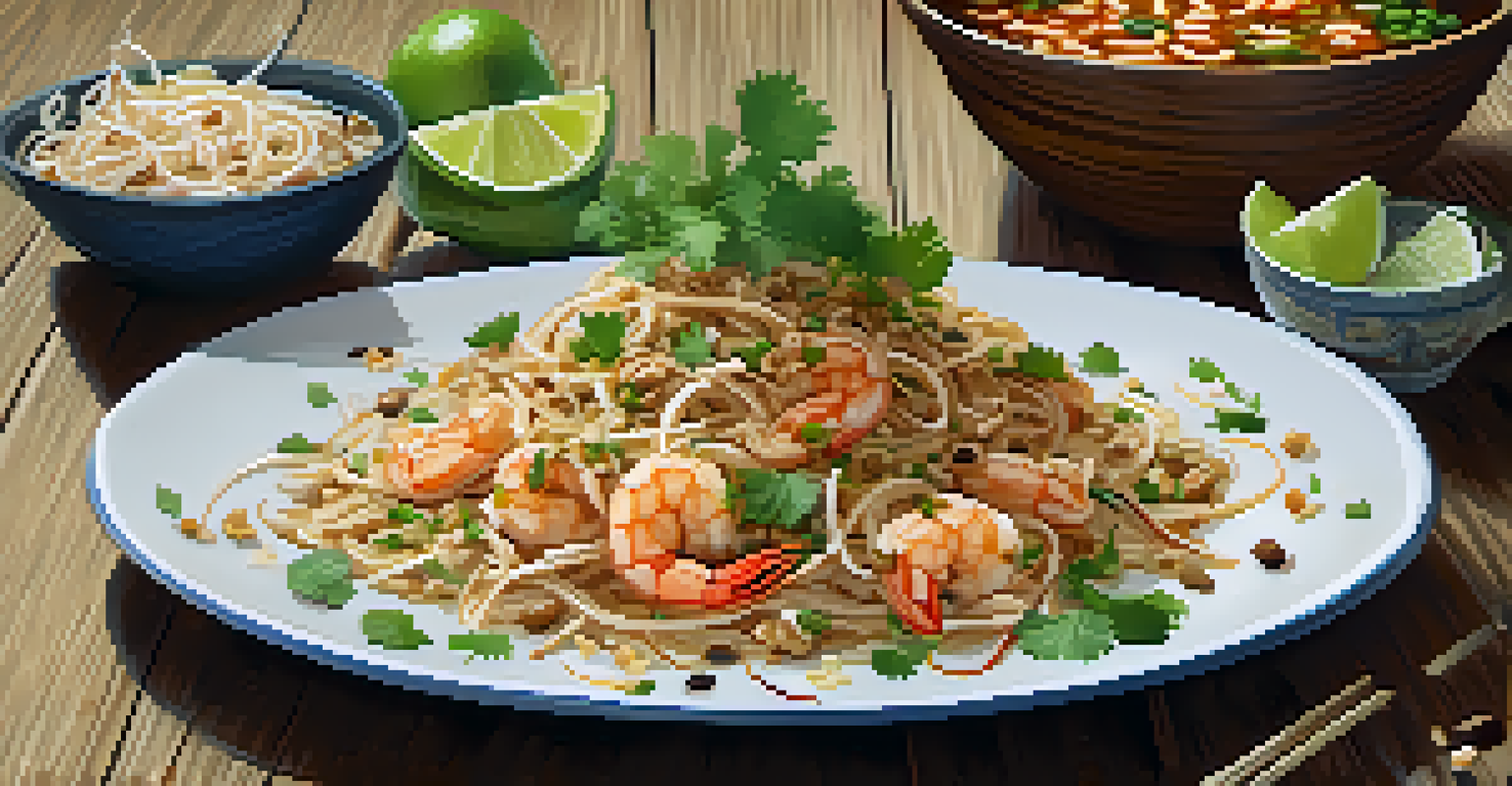Essential Ingredients for Traditional Thai Dishes

The Heart of Thai Flavor: Fresh Herbs and Spices
One of the most distinctive features of traditional Thai cuisine is its vibrant use of fresh herbs and spices. Ingredients like cilantro, basil, and lemongrass not only add depth but also contribute fresh, aromatic notes that awaken the palate.
Thai cuisine balances sweet, sour, salty, and spicy flavors in a way that is both complex and harmonious.
These herbs serve as the backbone of many Thai dishes. For example, Thai basil is a key player in stir-fries and curries, imparting a unique flavor profile that changes the entire dish. It's this careful balance of flavors that keeps Thai food exciting.
Moreover, spices like chili and galangal bring heat and complexity. A single bite can transport you to the bustling streets of Bangkok, where these ingredients are used daily to create mouthwatering meals.
Essential Sauces: Fish Sauce and Soy Sauce
Fish sauce, or 'nam pla', is a staple in Thai cooking, renowned for its umami richness. This fermented condiment is made from fish and salt, and it adds a salty, savory depth that’s hard to replicate with other ingredients.

Incorporating fish sauce into a dish can enhance flavors remarkably. Just a splash can transform a simple vegetable stir-fry into a tantalizing treat, showcasing how essential this ingredient is to authentic Thai cuisine.
Fresh Herbs Define Thai Cuisine
The vibrant use of fresh herbs like basil and cilantro adds aromatic depth and balances flavors in traditional Thai dishes.
Soy sauce also plays a role, particularly in northern Thai dishes. Both sauces together create a harmonious balance of salty, sweet, and savory notes that define the complexity of Thai flavors.
Coconut Milk: The Creamy Element in Thai Cooking
Coconut milk is another cornerstone of traditional Thai recipes, bringing a rich and creamy texture to dishes like curries and soups. Its natural sweetness balances the heat from spices, creating a well-rounded flavor experience.
The essence of Thai cooking lies in the use of fresh ingredients and bold flavors that create a tantalizing experience.
When simmered with spices and vegetables, coconut milk becomes a luxurious sauce that envelops every ingredient. Dishes like Tom Kha Gai, a chicken coconut soup, showcase how this ingredient can transform a simple meal into something extraordinary.
Additionally, coconut milk is versatile and can be used in desserts, adding a subtle sweetness that pairs beautifully with tropical fruits, making it an essential component of Thai cuisine.
Lime Juice: A Zesty Kick to Thai Dishes
Lime juice is essential in Thai cooking, providing a fresh, tangy brightness that elevates the overall flavor. It’s often used in salads, sauces, and marinades, ensuring that each bite is bursting with freshness.
For example, in the iconic Thai salad known as 'som tum' (green papaya salad), lime juice is key to balancing the sweetness of palm sugar and the heat of the chili. This interplay of flavors is a hallmark of Thai culinary art.
Essential Sauces Enhance Flavor
Fish sauce and soy sauce are crucial in Thai cooking, providing umami richness and a harmonious blend of salty, sweet, and savory notes.
Moreover, lime leaves can also be used to infuse dishes with a subtle citrus aroma, further enhancing the complexity and freshness of Thai cuisine.
Rice and Noodles: The Base of Thai Meals
In Thailand, rice is more than just a side dish; it’s the foundation of every meal. Jasmine rice, with its fragrant aroma, is often served alongside curries and stir-fries, making it an essential ingredient in traditional dining.
Noodles also hold a significant place in Thai cuisine. Dishes like Pad Thai showcase the versatility of rice noodles, which absorb flavors beautifully and offer a satisfying texture that complements the myriad of ingredients used.
Whether it’s rice or noodles, these staples are crucial in balancing the bold flavors of Thai cooking, providing a comforting base that enhances the overall dining experience.
Palm Sugar: Sweetness with a Distinct Flavor
Palm sugar is a unique sweetener commonly used in Thai cuisine, offering a rich caramel flavor that differs from regular sugar. Its natural sweetness adds depth to both savory and sweet dishes, making it a versatile ingredient.
In desserts like sticky rice with mango, palm sugar is often used to create a syrup that perfectly complements the dish. This sweetener not only balances flavors but also contributes to the characteristic taste of traditional Thai sweets.
Coconut Milk Adds Creamy Richness
Coconut milk brings a luxurious texture and natural sweetness to curries and soups, balancing the heat from spices.
Moreover, palm sugar is often used in savory dishes to counteract the heat from chilies, demonstrating the delicate balance Thai chefs achieve in their cooking.
Chilies: The Spice of Thai Life
Chilies are iconic in Thai cooking, providing the heat that many people crave. From fresh bird's eye chilies to dried varieties, they add a vibrant kick that keeps Thai dishes exciting and full of flavor.
In many traditional recipes, chilies are not just an afterthought; they are integral to the dish’s identity. For instance, a classic green curry is known for its spicy kick, primarily derived from green chilies blended into the curry paste.

Beyond the heat, chilies also contribute color and visual appeal, making each dish look as good as it tastes. This attention to both flavor and presentation is what makes Thai cuisine so captivating.
Aromatics: Garlic and Shallots in Thai Cooking
Garlic and shallots are foundational aromatics in Thai cuisine, often used to build flavor from the very beginning of a dish. These ingredients are sautéed to create a fragrant base that enhances the taste of whatever follows.
For example, in dishes like stir-fried morning glory, garlic is sautéed until golden, releasing a savory aroma that gets your taste buds tingling. This simple step is crucial in developing the rich, layered flavors characteristic of Thai cooking.
Moreover, the balance between garlic's pungency and shallots' sweetness creates a depth of flavor that is essential in many traditional recipes, showcasing the sophisticated techniques behind Thai culinary artistry.